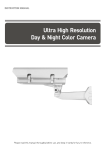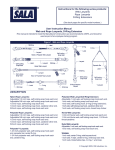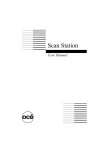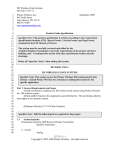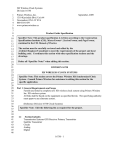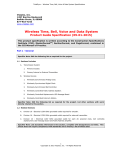Download Océ Machine Monitor - Océ | Printing for Professionals
Transcript
Océ Machine Monitor User Manual Océ-Technologies B.V. This manual contains a description of Océ Machine Monitor. Trademarks HP-GL, HP-GL/2, HP-RTL are trademarks of Hewlett Packard Company Microsoft, MS and MS Access and Windows are registered trademarks of Microsoft Corporation CalComp is a trademark of California Computer Products Inc. Intel and Pentium are registered trademarks of Intel Corporation. Adaptec is a registered trademark of Adaptec, Inc. Novell is a trademark of Novell Inc. TIFF is a trademark of Aldus Corporation CALS is a military standard Copyright Océ-Technologies B.V. Venlo, The Netherlands © 1999 All rights reserved. No part of this work may be reproduced, copied, adapted, or transmitted in any form or by any means without written permission from Océ. Océ-Technologies B.V. makes no representation or warranties with respect to the contents hereof and specifically disclaims any implied warranties of merchantability or fitness for any particular purpose. Further, Océ-Technologies B.V. reserves the right to revise this publication and to make changes from time to time in the content hereof without obligation to notify any person of such revision or changes. Code number 7114446 Edition 3.0 GB Contents Chapter 1 Introduction Introduction 6 Concept for Océ 9700/9800 7 Océ scanning and printing applications 7 Job information 11 Concept for Océ 9400 series 12 Using this manual 14 Related documentation for Océ 9700/9800 connection 14 Related documentation for Océ 9400 series connection 14 Chapter 2 Getting started Installation 16 Starting Machine Monitor 17 Starting manually 17 Starting automatically 18 Starting via Repro Station or Scan Station 18 Preparations for Océ 9700/9800 19 Defining the interface language 19 Defining printer configuration 20 Defining SCSI 21 Defining network 22 Defining printer stamps 24 Defining a list of users and accounts 24 Defining job information (statistics) 26 Defining rolls and media 28 Defining preferences 28 Preparations for Océ 9400 series 30 Defining the interface language 30 Defining printer configuration 30 Defining SCSI 31 Defining network 33 Defining a list of users and accounts 33 Defining preferences 36 Quitting Machine Monitor 37 Using help 38 Contents 3 Chapter 3 Using Machine Monitor Machine Monitor with Océ 9700/9800 40 Window display 40 Job history 41 Using the job history database 41 Machine status 41 Printer error 42 Connection error 42 Machine Monitor with Océ 9400 series 44 Window display 44 Connection error 45 Appendix A Data Base Contents Data Base Contents 48 Accounting Information 49 Extended Accounting 51 Appendix B Miscellaneous Notation conventions 54 Reader’s comment sheet 55 Addresses of local Océ organisations 57 Index 59 4 Océ Machine Monitor User Manual Océ Machine Monitor User Manual Chapter 1 Introduction The printing, scanning, and copying process. The concept of Machine Monitor. 5 Introduction Océ Machine Monitor is a software module that can be used in combination with different Océ printers/scanners: ■ ■ Océ 9700/9800 Océ 9400 series Depending on the Océ printer/scanner that is used, Océ Machine Monitor can be used for different purposes, as explained in the following sections. 6 Océ Machine Monitor User Manual Concept for Océ 9700/9800 An Océ large format print system will primarily be used in central reproduction environments. Remote control, speed and integrated finishing capabilities make the Océ printer the ideal solution in these environments. Files that are sent to the printer will be printed, sorted and folded on request. This results in greatly improved productivity over traditional printing and copying. Combined with a special software application, the Océ print system allows you to productively scan paper drawings and convert them to digital files. Prints, hard copy drawings and print files are not the only form of information entering repro departments. Equally important is information regarding: ■ ■ ■ how copies should be produced, how sets should be printed ready for distribution, how prints are to be distributed. This type of additional information is traditionally communicated via telephone, fax, or internal electronic mail. Rather than improving just part of the reproduction process, the Océ scanning and printing applications include all these information aspects. Océ scanning and printing applications The Océ scanning and printing applications support the digitalisation of engineering drawings, and/or the high-volume reproduction of digital engineering drawings. These applications are supplied by four software modules: ■ ■ ■ ■ Job Director Repro Station Scan Station Machine Monitor (described in this manual) Introduction 7 Job Director Job Director is a Microsoft Windows application which runs on PCs, ideally in a network. It allows users to create, edit and send reproduction requests - jobtickets or matrix tickets - from any PC to Repro Station. For more information, see the Océ Job Director User Manual. Repro Station Repro Station is a Microsoft Windows application which controls printing on the Océ printer. All print jobs go through Repro Station where they are queued, logged and managed. Repro Station supports the following functions: ■ accept plain print files, print files with Océ header information and digital reproduction requests (job tickets), ■ provide queuing and other system management functions to the operator of the printer, ■ control the Océ printer to produce complete sets of documents: sorted, folded and deposited in one of the output devices of the printer, ready for distribution. Apart from job requests initiated by Job Director, Repro Station also accepts print jobs and check plots from other sources, like printer drivers or document management systems. Job tickets must comply with the job ticket format specification as described in the ‘Océ Job Ticket Interface Programmer's Manual’. For more information, see the Océ Repro Station User Manual. Scan Station Scan Station is a Microsoft Windows application which allows you to control the scanning (also called upload) process. You can specify settings like resolution and file format. You also specify where the resulting files must be stored, which can be a network disk. When a file has been received by Scan Station you may view it on the PC's screen to check the quality of the scan. If you are using a software application to generate Scan Tickets, the required setttings on Scan Station will be made automatically for each drawing. For more information, see the Océ Scan Station User Manual. Machine Monitor Machine Monitor is in fact part of the Repro Station and/or Scan Station concept. Repro Station and Scan station can send print jobs to the printer via Machine Monitor. If both Repro Station and Scan Station want to send a job, Machine Monitor decides which job comes first, and which job has to wait. 8 Océ Machine Monitor User Manual If the printer supports back channel communication, Machine Monitor can also collect information from the printer, and send this information to Repro Station or Scan Station. In this way the following information can be collected: ■ ■ ■ ■ Status information Printer settings, e.g. engine configuration, printer stamps Rolls and media information Job information (statistics) The Océ 9700/9800 scanning and printing concept is shown in figure 1 on page 10. This manual describes Machine Monitor in more detail. Introduction 9 . Floppy disk Job Director A Job Ticket Network Hard disk Job Director B Job Director C check plots print files jobs Repro Station queue scanned files Repro Station Scan Station Scan Ticket Ready queue Local or Remote (TCP/IP) connection Machine Monitor SCSI connection Local or Remote (TCP/IP) connection Job database Scanner Printer [1] Océ 9700/9800 scanning and printing concept 10 Océ Machine Monitor User Manual Job information Machine Monitor collects job information about each job that is copied, printed, or scanned by the printer. This information is stored in an ODBC (Open Data Base Connection) compatible database. Many items per job are recorded. Among these are: ■ ■ ■ ■ date time user and account number used media - standard formats: number of copies - non-standard formats: number of length meters You can use any database application capable of reading this ODBC file, to create your own statistics application. Introduction 11 Concept for Océ 9400 series Océ Machine Monitor is one of the software modules you need to productively scan hard copy drawings on an Océ 9400, and convert them to digital files. In that case you will also need another software module: Océ Scan Station 9400 series. The scans can be viewed on the Scan Station screen with the built-in viewer, or on paper when a check plot is requested. Océ Scan Station 9400 series Océ Scan Station 9400 series is a Microsoft Windows application which allows you to control the scanning (also called upload) process. You can specify settings like resolution and file format. You also specify where the resulting files must be stored, which can be a network disk. When a file has been received by Scan Station you may view it on the PC's screen to check the quality of the scan. If you are using a software application to generate Scan Tickets, the required setttings on Scan Station will be made automatically for each drawing. For more information, see the Océ Scan Station 9400 series User Manual. Machine Monitor Machine Monitor provides the communication between the Océ Scan Station 9400 series and the Océ 9400 series printer/scanner. This manual describes Machine Monitor in more detail. 12 Océ Machine Monitor User Manual . Floppy disk Network Hard disk scanned files Scan Ticket Scan Station Local or Remote (TCP/IP) connection Machine Monitor SCSI connection Scanner Printer [2] Océ 9400 scanning concept Introduction 13 Using this manual This manual is intended for the operator of Machine Monitor. The user of Machine Monitor is often also the operator of the Océ printer/copier. It is assumed that you have some understanding of the Océ printer. More information can be found in the User Manual of the appropriate printer. This manual explains: ■ ■ how to install Machine Monitor and how to get things up and running (see chapter 2, ‘Getting started’ on page 15). how to use Machine Monitor (see ‘Using Machine Monitor’ on page 39). Related documentation for Océ 9700/9800 connection Océ 9800 Copier Printer User Manual Océ 9800 Printer User Manual Océ 9700 Copier Printer User Manual Océ 9700 Printer User Manual Océ Job Director User Manual Océ Repro Station User Manual Océ Scan Station User Manual Océ View Station User Manual Océ Job Ticket Interface Programmer’s Manual Océ Remote Control Format Reference Manual Related documentation for Océ 9400 series connection Océ 9400 User Manual Océ 9400-II User Manua Océ 9400 Scan Station User Manual Océ View Station User Manual 14 Océ Machine Monitor User Manual Océ Machine Monitor User Manual Chapter 2 Getting started How to install the software on your Windows PC. What preparations are required before you can actually use it. 15 Installation The recommended hardware for Machine Monitor is: ■ a PC with Pentium 90 MHz Intel processor, running Windows 95 or Windows NT version 3.51 or 4.0. Note: Although not recommended, Machine Monitor will also run on Windows version 3.1/3.11. ■ internal memory of 32 MByte. ■ a PC SCSI-Board (Adaptec 2940AU) including EZ-SCSI software. ■ a TCP-IP network (needed for remote connections). Before installing Machine Monitor, you must install the SCSI connection to the printer. ▼ Installing the SCSI connection 1 Install the Adaptec SCSI board on the PC. 2 Install the EZ-SCSI software. 3 Connect the Océ 9400/9700/9800 and make sure that it is recognized as ‘Tandberg TDC 3600’. Attention: Normally you will install Machine Monitor automatically with other applications, like Repro Station or Scan Station. However, it is possible to install Machine Monitor separately, as described in the following procedure. ▼ Installing Machine Monitor 1 Insert the CD ROM into the CD ROM drive. 2 Now follow the instructions in the CD ROM’s booklet. 16 Océ Machine Monitor User Manual Starting Machine Monitor You can start Machine Monitor in several ways, just like any other Windows program. Follow the procedure below. Stopping Océ Machine Monitor is explained in ‘Quitting Machine Monitor’ on page 37. Starting manually Note: Machine Monitor must be running before Repro Station or Scan Station can make a connection. ▼ To start Océ Machine Monitor manually 1 Switch on the printer. 2 If the printer is ready, switch on the PC. 3 Start MS-Windows. 4 Double-click the Machine Monitor-icon in the program group you just created. The Machine Monitor main window will be displayed as shown in the illustration below: 2329-144 [3] Machine Monitor main window Getting started 17 Note: Depending on the selected printer type, the main window may look differently. The very first time you start Machine Monitor: 1 You must enter your name and the name of your company. This will be displayed on the start up screen. Note: The first time you start Machine Monitor, it creates an initialization file named ocemm.ini in the directory in which the software is installed. This file contains your default settings. Starting automatically Put Machine Monitor in the Start Up group. When Windows is started, Machine Monitor is started automatically. ▼ To start Machine Monitor automatically 1 Switch on the printer. 2 If the printer is ready, switch on the PC. 3 Start MS-Windows. If Machine Monitor is put in the Start Up group, it will be started up automatically. Starting via Repro Station or Scan Station When you have selected Local network in Repro Station or Scan Station, and you start these applications, Machine Monitor is started automatically, if not already running. ▼ To start Machine Monitor via Repro Station or Scan Station 1 Switch on the printer. 2 If the printer is ready, switch on the PC. 3 Start up Repro Station or Scan Station. If you have selected ‘Local network’ in these applications, Machine Monitor will be started up automatically. 18 Océ Machine Monitor User Manual Preparations for Océ 9700/9800 After the first installation you need to define several settings, as described in the following sections. When your printer supports ‘backchannel communication’, the following settings are filled in automatically when the printer is connected and running: ■ ■ ■ Printer configuration: - Machine ID - Measurement units (mm or inch) - Finishing devices (folder, puncher...) Installed media: - For each roll: width and medium (paper, polyester...) Printer stamps: - All stamp strings as defined on the printer If one of these auto-filled settings is changed on the printer, it will automatically be changed on Machine Monitor as well. Auto-filled settings are indicated with a * sign in the following procedures. In the according windows, they are presented as ‘read-only’ information. The proper sequence is: 1 Connect PC and printer via SCSI. 2 Switch on the printer. 3 If the printer is ready, switch on the PC. 4 Make the required settings in the order as described below. Defining the interface language You can set the language of Machine Monitor menus, dialog boxes and online help as follows: Getting started 19 ▼ Setting the interface language 1 From the Configure menu choose Language. The following dialog box appears: 2316-144 [4] Language window 2 Open the drop-down list box and select the appropriate language. 3 Click OK. The working language of Machine Monitor will be changed. Defining printer configuration Machine Monitor must have some information about the features supported by your printer. You have to specify whether your printer uses mm or inches and which output and finishing devices are present. ▼ Specifying the printer configuration 1 From the Configure menu choose Printer. The Printer dialog box appears: 2322-144 [5] Printer dialog box 20 Océ Machine Monitor User Manual 2 Specify the printer type: Océ 9800 EPC: For current version of the Océ 9800 with backchannel communication. ■ Océ 9800 FBBS: Only for older versions of the Océ 9800 without backchannel communication. ■ Océ 9700 EPC: For connection to the Océ 9700. Specify a printer name. You are free to specify your own printer name. This name will appear in the title bar of the main window. Enter the machine ID* Click either one of the units* which your printer is configured to use (mm or inch). Click the appropriate check boxes of the finishing devices*, corresponding to your particular printer configuration. Click OK to save your settings or click Cancel to discard the changes. ■ 3 4 5 6 7 Defining SCSI Use the SCSI setup dialog box to configure the SCSI parameters of the Machine Monitor PC. This needs to be done only once after installation of Machine Monitor. The ‘Scan for SCSI devices’ function scans the SCSI bus and returns the available Host adapter ID/Target ID pairs in the list box. Select the pair that belongs to the attached printer. The Ready time out is the time you allow the system to receive data from the printer or from the scanner. The Write time out is the time you allow the system to try to transmit data to the printer or to the scanner. Getting started 21 ▼ Defining SCSI setup 1 Switch printer and scanner on and wait until they are ready. 2 From the Configure menu select SCSI. The SCSI setup dialog box appears: 2334-144 [6] SCSI dialog box 3 Click the Scan for SCSI devices button. 4 Click the SCSI ID pair that belongs to the attached printer. The IDs will be copied to the Host adapter ID and Target adapter ID boxes in the SCSI setup window. 5 Specify the write timeouts for printing and scanning. 6 Specify the ready timeouts for printing and scanning. 7 Click OK to save your settings or click Cancel to discard the changes. Defining network This setting specifies the socket/network connections that are available for your applications. You need to specify the port number to which Repro Station and Scan Station can connect. 22 Océ Machine Monitor User Manual ▼ Specifying network 1 From the Configure menu choose Network. The following window appears: 2323-144 [7] Network setup dialog box 2 Enter the number of the scanner port. 3 Enter the number of both printer ports. 4 Click OK to save your settings or click Cancel to discard the changes. Normally the default values do not have to be changed. If however, another application already uses these ports, you may choose another port number here. Default the following port numbers are used: ■ ■ Océ Scan Station: Océ Repro station: 2000 2001. When you change the port numbers here, you must also change the port number in the Scan Station or Repro Station application. Getting started 23 Defining printer stamps In the Stamp dialog box the printer stamps are specified. ▼ Specifying printer stamps 1 From the Configure menu choose ‘Printer stamps’. The following dialog box appears: 2324-144 [8] Stamp dialog box 2 Specify a number, ranging from 1 to 50 to identify the stamp. 3 In the Context box, type the stamp string* as it is currently defined in the printer. 4 If required, repeat step 2 and 3 until you have defined all available strings. 5 Click OK to save your settings or click Cancel to discard the changes. Defining a list of users and accounts You can define a list of users and accounts, e.g. departments, to allow print job management. This list is used for the following purposes: ■ ■ ■ 24 Statistics In the list a number is assigned to each user and account. This number is used for statistical purposes (job logging) by Machine Monitor. Print permission In Repro Station you can restrict printing. If this option is selected, only users and/or accounts that are defined in the list are allowed to send jobs to the printer. Bin selection High Capacity Stacker If your printer is equipped with a High Capacity Stacker, you can use the list to define which output bin should be used for a specified user and/or account. In Repro Station you can define if this specified bin is to be used. Océ Machine Monitor User Manual Note: The assignmement of output bins to the list of users and accounts can only be made in Repro Station. Assigning user and account names to Scan Station jobs. In Scan Station you can select user and account names from the list to assign to scan jobs and check plots. ■ You can define a list of users and accounts in Repro Station, Machine Monitor and Scan Station. If the applications are installed correctly, only one list of users and accounts is used. You can use any of the named applications to add users and accounts to this list, or to remove them. Attention: Only if Machine Monitor, Repro Station and Scan Station are installed on the same PC and in the same directory, the named applications will use the same list: the ASCII file ‘accounts.txt’. If installed on different PC’s, after changing the list you must copy the file ‘accounts.txt’ in the directory ‘Accounts’ (one directory higher than the directory where the Océ software resides) to the same place on the PC where the software of the other named applications resides. ▼ Adding Users and accounts to the list 1 From the Configure menu, choose ‘Users and accounts’. The Users and Accounts dialog box appears. 2325-144 [9] The Users and accounts dialog box 2 In the Name box of the Users and/or Accounts, type the respective name of the user or account user you wish to define. For example, an account name could be the name of a department: ‘Sales’. 3 In the Number box, type the number you wish to assign to the user or account (you can enter up to 9 digits). If you click the button that is located at the right side of the number field, the first free number (following the currently Getting started 25 displayed number) will appear. This number is not in use for other users or accounts. 4 Choose the Add button. 5 Repeat steps 2 to 4 to add all the users and accounts of your choice. 6 Click the OK button. ▼ Removing Users and accounts from the list 1 From the Configure menu, choose ‘Users and accounts’. The Users and Accounts dialog box appears (see figure 9). 2 Click the button behind the Name box of the Users and/or Accounts to select a user or account you want to remove from the list. 3 Click the appropriate ‘Delete’ button to remove the selected user or account from the list. 4 If you want to remove all users or all accounts from the list, click the appropriate ‘Delete all’ button. 5 Click the OK button. Defining job information (statistics) You can specify the data base file, to which the job information of all jobs will be written. You can also specify that at regular times a new database file must be created automatically. 26 Océ Machine Monitor User Manual ▼ Specifying Database 1 From the Configure menu choose Database. The Database dialog box appears: 2326-144 [10] Database dialog box 2 Select Store job info: Yes/No. 3 If you selected Yes, define one of the following options: Fixed database filename: Use the Browse button to define the directory and name of the database file. ■ New database filename Select how often a new database file must be created: daily/weekly. Use the Browse button to define the directory in which the database files should be written. The name of the database files will be generated automatically, depending on the previous setting: - daily: for example 96_10_11.mdb if the date is 11 October 1996. - weekly: for example 1996_41.mdb if the date is in week number 41 of 1996. 4 Click OK to save the changes, or click Cancel to discard the changes. ■ Getting started 27 Defining rolls and media The rolls and media settings you have to specify are the following: ■ ■ ▼ the available media the available roll widths Specifying installed rolls and media 1 From the Configure menu choose ‘Rolls and media’. The Rolls and Media dialog box appears: 2327-144 [11] Media dialog box Note: The Océ 9700 supports maximal three rolls. 2 If your printer supports back channel communication, these are read only fields*. If your printer does not support back channel communication, make the settings manually. 3 Click Apply to save the changes or click Cancel to discard the changes. Defining preferences The Preferences dialog box is used to: ■ specify whether Machine Monitor should come up as a window or as an icon ■ specify if and how you want to be informed about errors ■ specify how often the printer is asked for status and job information. Note: The printer keeps information of a maximum of 50 jobs in memory. All available information is provided when asked for by Machine Monitor. ■ specify the number of jobs in the history list on the screen 28 Océ Machine Monitor User Manual ▼ To specify preferred settings 1 From the Configure menu choose Preferences. The Preferences dialog box appears: 2328-144 [12] Preferences dialog box 2 Click the required startup method. 3 Click the required action if an error occurs: display of errors (yes or no), visual or audio. 4 Specify how often the printer is asked for status and job information. 5 Specify the number of jobs in the history list on the screen. Note: This does not affect the logging of jobs in the database, just the length of the list in the main window. 6 Click OK to save the changes or click Cancel to discard the changes. Getting started 29 Preparations for Océ 9400 series After the first installation you need to define several settings, as described in the following sections. The proper sequence is: 1 Connect PC and printer via SCSI. 2 Switch on the printer. 3 If the printer is ready, switch on the PC. 4 Make the required settings in the order as described below. Defining the interface language You can set the language of Machine Monitor menus, dialog boxes and online help as follows: ▼ Setting the interface languageseries 1 From the Configure menu choose Language. The following dialog box appears: 2316-144 [13] Language window 2 Open the drop-down list box and select the appropriate language. 3 Click OK. The working language of Machine Monitor will be changed. Defining printer configuration You must specify the type of printer you want to connect to. This setting determines the appearance of the main window, and the contents of several menus. 30 Océ Machine Monitor User Manual ▼ Specifying the printer configuration 1 From the Configure menu choose Printer. The Printer dialog box appears: 2336-144 [14] Printer dialog box 2 Select the printer type: Océ 9400 series. 3 Specify a printer name. You are free to specify your own printer name. This name will appear in the title bar of the main window. 4 Click OK to save your settings or click Cancel to discard the changes. Defining SCSI Use the SCSI setup dialog box to configure the SCSI parameters of the Machine Monitor PC. This needs to be done only once after installation of Machine Monitor. The ‘Scan for SCSI devices’ function scans the SCSI bus and returns the available Host adapter ID/Target ID pairs in the list box. Select the pair that belongs to the attached printer. The Ready time out is the time you allow the system to receive data from the Océ 9400. The Write time out is the time you allow the system to try to transmit data to the Océ 9400. Getting started 31 ▼ Defining SCSI setup 1 Switch printer and scanner on and wait until they are ready. 2 From the Configure menu select SCSI. The SCSI setup dialog box appears: 2318-144 [15] SCSI dialog box 3 Click the Scan for SCSI devices button. 4 Click the SCSI ID pair that belongs to the attached printer. The IDs will be copied to the Host adapter ID and Target adapter ID boxes in the SCSI setup window. 5 Specify the write timeout for scanning. 6 Specify the ready timeout for scanning. 7 Click OK to save your settings or click Cancel to discard the changes. 32 Océ Machine Monitor User Manual Defining network You need to specify the port number to which Scan Station can connect. ▼ Specifying network 1 From the Configure menu choose Network. The following window appears: 2319-144 [16] Network setup dialog box 2 Enter the number of the scanner port. 3 Click OK to save your settings or click Cancel to discard the changes. Normally the default value does not have to be changed. If however, another application already uses this port, you may choose another port number here. Default the following port number is used: ■ Océ Scan Station: 2000 When you change the port number here, you must also change the port number in the Scan Station application. Defining a list of users and accounts You can define a list of users and accounts, e.g. departments, assigning a number to each user and account. In Scan Station you can select user and account names from the list to assign to scan jobs and check plots. Scan Station will write the numbers of the selected user and account in a log file. You can define a list of users and accounts in Machine Monitor and Scan Station. If the applications are installed correctly, only one list of users and accounts is used. You can use any of the named applications to add users and accounts to this list, or to remove them. Getting started 33 Attention: Only if Machine Monitor and Scan Station are installed on the same PC and in the same directory, the named applications will use the same list: the ASCII file ‘accounts.txt’. If installed on different PC’s, after changing the list you must copy the file ‘accounts.txt’ in the directory ‘Accounts’ (one directory higher than the directory where the Océ software resides) to the same place on the PC where the software of the other named application resides. ▼ Adding Users and accounts to the list 1 From the Configure menu, choose ‘Users and accounts’. The Users and Accounts dialog box appears: 2320-144 [17] The Users and accounts dialog box 2 In the Name box of the Users and/or Accounts, type the respective name of the 3 4 5 6 34 user or account user you wish to define. For example, an account name could be the name of a department: ‘Sales’. In the Number box, type the number you wish to assign to the user or account (you can enter up to 9 digits). If you click the button that is located at the right side of the number field, the first free number (following the currently displayed number) will appear. This number is not in use for other users or accounts. Choose the Add button. Repeat steps 2 to 4 to add all the users and accounts of your choice. Click the OK button. Océ Machine Monitor User Manual ▼ Removing Users and accounts from the list 1 From the Configure menu, choose ‘Users and accounts’. The Users and Accounts dialog box appears (see figure 17). 2 Click the button behind the Name box of the Users and/or Accounts to select a user or account you want to remove from the list. 3 Click the appropriate ‘Delete’ button to remove the selected user or account from the list. 4 If you want to remove all users or all accounts from the list, click the appropriate ‘Delete all’ button. 5 Click the OK button. Getting started 35 Defining preferences The Preferences dialog box is used to specify whether Machine Monitor should come up as a window or as an icon ▼ To specify preferred settings 1 From the Configure menu choose Preferences. The Preferences dialog box appears: 2321-144 [18] Preferences dialog box 2 Click the required startup method. 3 Click OK to save the changes or click Cancel to discard the changes. 36 Océ Machine Monitor User Manual Quitting Machine Monitor You can stop Machine Monitor by selecting Exit from the File menu. Any current job is finished, except if you really want to stop in the middle of a transfer. Depending on the currently active process (printing, scanning or copying) a message comes up asking if the current job must be aborted or not. ▼ Stop Machine Monitor 1 From the File menu choose Exit. You are asked if the active print or scan process must be aborted or not. Getting started 37 Using help On-line help for Machine Monitor is a quick and convenient way to look up information about a task you are performing, a feature you would like to know more about, or a command you want to use. Help is available whenever you see a Help command button, or help as an item on the menu bar. When you select help from the menu, the first page of Machine Monitor help appears. ▼ Using the Help menu 1 From the Help menu choose Contents. You can also press F1 at any time for help information. For menus, the Status bar at the bottom of the window also displays a one-line text to explain the purpose of the currently selected menu item. 38 Océ Machine Monitor User Manual Océ Machine Monitor User Manual Chapter 3 Using Machine Monitor How to use Machine Monitor in combination with an Océ 9700/9800 or Océ 9400 series scanner/printer. The functions of the main window are explained. 39 Machine Monitor with Océ 9700/9800 This section will explain the usage of Machine Monitor in combination with an Océ 9700/9800 printer/scanner with backchannel communication (EPC). Note: If you are using an Océ 9800 without backchannel communication (FBBS), the main window will not show information about job history or machine status, and you can not use the job history database. Window display When the Machine Monitor is running, the main window may be minimized or opened. Note: In the Preference dialog box, you can select the ‘visual’ checkbox in the ‘Display errors’ field (see figure 12 on page 29). If this checkbox is selected,and the window is minimized, the icon or the windows button in the taskbar will periodically change when an error occurs. 2330-144 [19] Main window of Machine Monitor combined with Océ 9700/9800 40 Océ Machine Monitor User Manual Job history The lower part of the main window shows the job history. At the top of this part the name of the current data base file is shown, followed by a list of jobs. Note: In the Preference dialog box you can define the number of jobs that are listed here (see figure 12 on page 29). The following information is shown for each job that is copied, printed or scanned: ■ ■ ■ ■ ■ ■ ■ Job ID Data and time the job was finished User ID Account ID Job type: Copy, Print or Scan (If the job is part of a matrix job, the # sign is displayed) Number of originals or files Total number of copies of the copy or print job Using the job history database Machine Monitor creates an MS Access database, compatible with the Open Data Base Connection (ODBC) standard. You can use (or develop your own) applications for advanced usage of the database. The exact contents is described in Appendix A: ‘Data Base Contents’ on page 47. Machine status The upper part of the main window shows the machine status. Normally, the status is ‘Ready’ or ‘Machine running’. Other messages that may appear are listed below: ■ ■ ■ ■ ■ Covers open... Service diagnostic mode... Warming up... Machine running... Printer needs attention! Using Machine Monitor 41 Printer error If a printer error occurs, the machine status ‘Printer needs attention!’ is displayed on the screen, and/or an audio signal is played once (see ‘Defining preferences’ on page 28). Solving the problem automatically removes the error message. Note: Also check the display of the printer or scanner for more detailed error messages. Connection error If a connection error occurs, the following window will appear: 2339-144 [20] Connection error Different problems may cause this message to appear on the screen. Depending on the kind of problem one of the following actions are recommended: Printing is disabled Check the function button ‘Print’ on the main menu of the operaring panel of the Océ 9700/9800. If this function is not activated, printing is disabled. In that case press the function button ‘Print’ to enable printing. Set copying is active If someone is feeding originals for a set copy job on the Océ 9700/9800, printing is disabled. After feeding all originals that belong to 42 Océ Machine Monitor User Manual the set, the end of the set must be confirmed by pressing the ‘Start’ button on the operating panel. This will enable the receiving of print jobs automatically. Job memory of the printer is full Check the memory indicator on the main menu of the operating panel (this indicator is only shown on the operating panel of the Océ 9800). If the memory is full and printing is enabled, the Océ 9700/9800 will continue to receive new print jobs automatically if the required amount of memory is available. The Océ 9700/9800 is switched off If the Océ 9700/9800 is switched off, you must switch on the system and wait until it is ready. If the message on the PC screen does not disappear, press ‘Cancel’ and shut down the PC. Shut down the Océ 9700/9800 and start it up again. Wait until the system is ready. Then start up the PC and the required software applications. SCSI connection failed If you have checked all the other possible causes, probably the SCSI connection has failed. In that case press cancel and shut down the PC and the Océ 9700/9800. Check the SCSI connection for damages to the cable and the connectors at the PC and the printer side. If the connection is OK you can start up the Océ 9700/9800 and wait until the system is ready. Then start up the PC and the required software applications. Using Machine Monitor 43 Machine Monitor with Océ 9400 series If Machine Monitor is combined with an Océ 9400 scanner/printer, it is not possible to show information about job history or machine status in the main window. Océ Scan Station 9400 series provides the possibility to collect job history informations about scan jobs in a log file. For more information see the Océ Scan Station 9400 series User Manual. Window display When the Machine Monitor is running, the main window may be minimized or opened. 2338-144 [21] Main window of Machine Monitor combined with Océ 9400 series 44 Océ Machine Monitor User Manual Connection error If a connection error occurs, the following window will appear: 2339-144 [22] Connection error Different problems may cause this message to appear on the screen. Depending on the kind of problem one of the following actions are recommended: The Océ 9400 is switched off If the Océ 9400 is switched off, you must switch on the system and wait until it is ready. If the message on the PC screen does not disappear, press ‘Cancel’ and shut down the PC. Switch off the Océ 9400 and start it up again. Wait until the system is ready. Then start up the PC and the required software applications. SCSI connection failed If the printer is switched on and ready to print, probably the SCSI connection has failed. In that case press cancel and shut down the PC and the Océ 9400. Check the SCSI connection for damages to the cable and the connectors at the PC and the printer side. If the connection is OK you can start up the Océ 9400 and wait until the system is ready. Then start up the PC and the required software applications. Using Machine Monitor 45 46 Océ Machine Monitor User Manual Océ Machine Monitor User Manual Appendix A Data Base Contents If Machine Monitor in connected to an Océ 9700/9800 printer with backchannel communication, you can use a database to collect job information. The contents of this data base is explained. 47 Data Base Contents The following tables show which information will be accounted in the job information database (one .mdb file). For each copy/print/scan job, or for each matrix program, the job info and the paper usage is stored. They are linked with the same “JobId” and “DateTime”, and uniquely identified by the “Key”. The paper usage is accounted like this: ■ ■ for standard formats, the number of copies is counted for non-standard formats, the amount of paper from a specific roll is given For example, a job produces 3 landscape A1s (from the A0 roll), 5 portrait A1s from the A1 roll, and a 6.3 meter plot from the A0 roll (all plain paper). Accounting Information Extended Accounting JobId DateTime A now JobId DateTime A now UserId AccountId TotalOriginals 12 34 3 PageFormat Media Copies Meters 1 0 8 0 JobId DateTime A now PageFormat Media Copies Meters 0 0 0 6.3 [23] Example of job information (statistics) So the statistics (reporting) application has to find the corresponding records and calculate the amount of paper used. Note: Manual feed input is accounted by selecting another kind of media. 48 Océ Machine Monitor User Manual Accounting Information Information for each job: Accounting Information type description Key Number (Long) unique identification of a database entry JobId Number (Long) identification of the job AccountId Number (Long) identification of the account number UserId Number (Long) identification of the user number MachineId Number (Long) identification of the machine DateTime Date/Time date and time the record was created (i.e. the job was accounted) PrintType Number (Byte) type of job: 0 = plot, 1 = copy, 2 = scan SortType Number (Byte) sorting: 0 = sort by page, 1 = sort by set TotalOriginals Number (Long) total number of originals in the job, i.e. entries in the printer’s memory (each entry is one “page”) TotalFolded Number (Long) total number of folded output pages TotalPunched Number (Long) total number of punched output pages TotalReinforced Number (Long) total number of reinforced output pages TotalStamped Number (Long) total number of output pages with a printer stamp TotalEdited Number (Long) total number of edited output pages TotalEnlarged Number (Long) total number of enlarged (zoom > 100%) output pages TotalReduced Number (Long) total number of reduced (zoom < 100%) output pages PaperPrints Number (Long) total number of output pages on plain paper PaperClicks Number (Long) total number of plain paper media clicks PolyesterPrints Number (Long) total number of output pages on ployester PolyesterClicks Number (Long) total number of polyester media clicks TransparentPrints Number (Long) total number of output pages on transparent media TransparentClicks Number (Long) total number of transparent media clicks ScanResolution Number (Integer) scan resolution in dpi ScanFileFormat Number (Byte) scan file format: 0 = TIFF, 1 = CALS [24] Accounting Information Data Base Contents 49 Accounting Information type description ScanWidth Number (Long) scan width in pixels ScanHeight Number (Long) scan length in pixels ScanFileSize Number (Double) scan file size in bytes ScanFileName Text name of the scanned file as it is stored on the host disk JobName Text name of the job PlotNumberOfFiles Number (Integer) number of files in the print job UserName Text name of the user; derived from the UserId AccountName Text name of the account; derived from the AccountId JobType Number (Byte) type of job: 0 = normal job, 1 = matrix job [24] Accounting Information 50 Océ Machine Monitor User Manual Extended Accounting The following table contains information about the paper sizes and media used. For each job, multiple records of this type are present; they are linked to Job Information by common JobID and DateTime fields. Extended Accounting type description Key Number (Long) unique identification of a database entry JobId Number (Long) identification of the job DateTime Date/Time date and time the record was created (i.e. the job was accounted) PaperFormat Number (Byte) format of the output pages (for standard sizes), or width of the output (for non-standard sizes); 0 = A0 1 = A1 2 = A2 3 = A3 4 = A4 5 = E, 34” x 44” 6 = D, 22” x 34” 7 = C, 17” x 22” 8 = B, 11” x 17” 9 = A, 8.5” x 11” 10 = E+, 36” x 48” 11 = D+, 24” x 36” 12 = C+, 18” x 24” 13 = B+, 12” x 18” 14 = A+, 9” x 12” 15 = B1, 707 x 1000 mm 16 = B2, 500 x 707 mm 17 = B3, 353 x 500 mm 18 = B4, 250 x 353 mm 19 = 30” x 42” 20 = 500 x 707 mm 21 = 707 x 1000 mm Media Number (Byte) media type: 0 = plain paper, 1 = transparent, 2 = polyester, 3 = manual Copies Number (Integer) number of copies for this (standard) format and media Meters Number (Double) number of meters printed for this (non-standard) format/width and media [25] Extended Accounting Data Base Contents 51 52 Océ Machine Monitor User Manual Océ Machine Monitor User Manual Appendix B Miscellaneous 53 Notation conventions There are a number of notation conventions used in this manual. This consistent style enables you to quickly become conversant with the use of this manual and consequently the Océ Machine Monitor. Description Each section or subsection contains a description of the feature or operation identified in the title. It might also include possible applications, as well as any guidelines that you should bear in mind. Procedures A description is followed by a procedure. A procedure always begins with a phrase which briefly describes the procedure, followed by a series of numbered steps that take you, step by step, through all phases of performing the operation. Figures and tables Figures and tables are titled and numbered sequentially throughout this manual. Figures include pictures of product components, screendumps, examples, and diagrams of concepts discussed in the description. Attention getters There are several types of information to which we draw your attention. This information is classified as follows: Note: In a ‘Note’, information is given about matters which ensure the proper functioning of the machine or application, but useful advice concerning its operation may also be given. Attention: The information that follows ‘Attention’ is given to prevent something (your copy or original, the copier or printer, data files etc.) being damaged. Caution: The information that follows ‘Caution’ is given to prevent you suffering personal injury. 54 Océ Machine Monitor User Manual Reader’s comment sheet Have you found this manual to be accurate? ❏ Yes ❏ No Could you operate the product after reading this manual? ❏ Yes ❏ No Does this manual provide enough background information? ❏ Yes ❏ No Is the format of this manual convenient in size, readability and arrangement (page layout, chapter order, etc.)? ❏ Yes ❏ No Could you find the information you were looking for? ❏ Always ❏ Most of the times ❏ Sometimes ❏ Not at all What did you use to find the required information? ❏ Table of contents ❏ Index Are you satisfied with this manual? ❏ Yes ❏ No Thank you for evaluating this manual. If you have other comments or concerns, please explain or suggest improvements overleaf or on a separate sheet. 7114446 Miscellaneous 55 Comments: ------------------------------------------------------------------------------------------------------------------------------------------------------------------------------------------------------------------------------------------------------------------------------------------------------------------------------------------------------------------------------------------------------------------------------------------------------------------------------------------------------------------------------------------------------------------- Date: This reader’s comment sheet is completed by: (If you prefer to remain unknown, please do fill in your occupation) Name: Occupation: Company: Phone: Address: City: Country: Please return this sheet to: Océ-Technologies B.V. For the attention of ITC User Documentation. P.O. Box 101, 5900 MA Venlo The Netherlands 56 Océ Machine Monitor User Manual Addresses of local Océ organisations Océ-Australia Ltd. P.O.Box 363 Ferntree Gully MDC VIC 3165 Australia Océ-Danmark A.S. Kornmarksvej 6 DK 2605 Brøndby Denmark Océ-Österreich GmbH Postfach 95 1233 Vienna Austria Océ-France S.A. 32, Avenue du Pavé Neuf, 93161 Noisy-le-grand, Cedex France Océ-Belgium N.V./S.A. Avenue J.Bordetlaan 32 1140 Brussels Belgium Océ-Deutschland GmbH Postfach 101454 4330 Mülheim an der Ruhr (13) Deutschland Océ-Brasil Comércio e Industria Ltda. Caixa Postal 3187 01060-970 Sao Paulo, SP Brazil Océ (Hong Kong China) Ltd. 12/F 1202 The Lee Gardens 33 Hysan Avenue, Causeway Bay Hong Kong Océ-Canada Inc. 525, Logan Avenue, Toronto, Ontario M4K 3B3 Canada Océ-Hungária Kft. P.O.B. 237 1241 Budapest Hungary Océ Office Equipment (Beijing) Co Ltd. Xu Mu Cheng Chaoyang District Beijing 100028 China Océ-Italia S.p.A. Strada Padana Superiore 2/B 20063 Cernusco sul Naviglio (MI) Italia Océ-Česká republika s.r.o. Hanusova 18 14021 Praha 4 Pankrác, Czech Republic Miscellaneous Océ Systems (Malaysia Sdn. Bhd.) #3.01, Level 3, Wisma Academy Lot 4A, Jalan 19/1 46300 Petalig Jaya Malaysia 57 Océ-Nederland B.V. P.O.Box 800 5201 AV ‘s-Hertogenbosch The Netherlands Océ (Taiwan) Ltd. No. 99-24 Nan Kang Road Sec.2 Taipeh, Taiwan Taiwan, RO Océ Norge A/S Postboks 53, Grefsen 0409 Oslo 4 Norway Océ (Thailand) Ltd. 16th Floor, B.B. Building 54 Asoke Road, Sukhumvit 21 Bangkok 10110 Thailand Océ-Poland Ltd. ul. Łopuszańska 53 02-232 Warszawa Poland Océ-Lima Mayer S.A. Av. José Gomes Ferreira, 11 Ed. Atlas II Miraflores 1495 Algés Portugal Océ (Far East) Pte. Ltd./ Océ (Singapore) Pte. Ltd., #03-00 Wisma Gulab 190 MacPherson Road Singapore 348548 Océ España SA Business Park MAS BLAU C/Osona 2, 2-3a Planta 08820 El Prat del Llobregat (Barcelona) Spain Océ-Svenska AB P.O.box 1231 S-164 28 Kista Sweden Océ-Schweiz AG Sägereistrasse 29 CH8152 Glattbrugg Switzerland 58 Océ Machine Monitor User Manual Océ-U.K.Ltd. Langston Road Loughton, Essex IG10 3SL United Kingdom Océ-USA Inc. 5450 North Cumberland Av. Chicago, Ill. 60656 U.S.A. Index A accounts 9400 series defining a list of users and - 33 9700/9800 defining a list of users and - 24 C configuration 9400 series defining printer - 30 9700/9800 defining printer - 20 D database 9700/9800 job history - 41 defining 9400 series language 30 list of users and accounts 33 network 33 preferences 36 printer configuration 31 scsi 32 9700/9800 database 27 installed media 28 job information 26 language 20 list of users and accounts 24 network 23 preferences 29 printer configuration 20 scsi 22 stamps 24 Index defining installed - 28 display 9700/9800 window 40, 44 documentation related - for 9700/9800 connection 14 related - for océ 9400 series connection 14 E error information 9700/9800 28, 42 exit machine monitor 37 H help, using - 38 history 9700/9800 job - database 41 job - showed on main window 41 I installation 16 J job director, defined 8 job history 9700/9800 - database 41 - showed on main window 41 job information 9700/9800 defining - 26 L language 9700/9800 defining - used on screen 20 59 list of users and accounts 9400 series defining a - 33 9700/9800 defining a - 24 9700/9800 defining - 28 printer configuration 9400 series defining - 30 9700/9800 defining - 20 M machine monitor explained 8 explained for océ 9400 series connection 12 quit 37 machine status 9700/9800 - showed on main window 41 media 9700/9800 28 Q quitting machine monitor 37 R repro station explained 8 interaction with job director 8 interaction with machine monitor 8 N network 9400 series defining - 33 9700/9800 defining - 22 O odbc 9700/9800 - compatible database 41 P ports 9400 series defining - on network 33 9700/9800 defining - on network 23 preferences 9400 series defining - 36 60 Océ Machine Monitor User Manual S scsi 9400 series ready time out 31 setup 31 write time out 31 9700/9800 ready time out 21 setup 21 write time out 21 starting machine monitor 17 automatic 18 via repro station 18 via scan station 18 statistics 9700/9800 defining - 26 stopping machine monitor 37 U users 9400 series defining 34, 35 9700/9800 defining 25, 26 users and accounts 9400 series defining a list of - 33 9700/9800 defining a list of - 24 W window display 9700/9800 40, 44 Index 61






























































![User's Manual[FBD1] ProMax ProMedia Converter](http://vs1.manualzilla.com/store/data/006881326_1-9e3a0042b45fc9f5f8ff38953ecf78a2-150x150.png)
